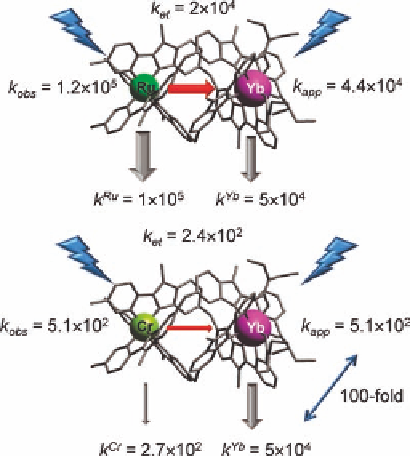Chemistry Reference
In-Depth Information
helicates (
M
¼Ru
II
,Cr
III
). Rate
constants are given in s
1
.
Redrawn from data published in Ref. [92].
n
þ
Figure 6.17
Energy migration processes in [Yb
M
(L25)
3
]
levels
k
Cr
10
2
s
1
(measured for [CrGd(L25)
3
]
6þ
), with the rate of energy transfer
¼
2.7
k
Cr;Yb
et
10
2
s
1
gives
k
Cr
k
Cr
k
Cr;Yb
et
10
2
s
1
. The latter value is small
compared with the inherent rate of deactivation of Yb
¼
2.4
obs
¼
þ
¼
5.1
10
4
s
1
(measured for [ZnYb(L25)
3
]
5þ
); this case is illustrated on the bottom of Figure 6.17. As
predicted by Equation 6.22, the experimental decay of the Yb-centred emission amounts
to
k
Yb
app
2
F
5=2
5=2
Þ
,
k
Yb
ð
¼
5.0
10
2
s
1
, which exactly matches the slow deactivation rate of the Cr
III
chromophore. These rate constants can be transformed into characteristic excited life-
times, thus leading to
¼
5.1
23 ms, when Yb
III
is sensitized by Ru
II
in [RuYb(L25)
3
]
5þ
,
Yb
app
t
¼
1.96ms, when Yb
III
is sensitized by Cr
III
in the isostructural complex
[YbCrL25)
3
]
6þ
. Such a lengthening of the lanthanoid-centred NIR luminescence by two
orders of magnitude demonstrates the tuning capacity of the dinuclear supramolecular
edifices and may be valuable for improving the sensitivity of time-gated bioanalyses, pro-
vided that a judicious choice of the donor is made. At low temperature, at which phonon-
assisted transfer would be minimized, Cr
III
is a better donor than Ru
II
and the efficiency of
the process decreases in the order Nd
III
Yb
app
and
t
¼
Yb
III
. The latter order is understandable
in that the overlap integral between the emission spectrum of the donor and the absorption
spectrum of the acceptor is largest for Nd
III
owing to more lanthanoid-centred excited
states in the 13-15 000 cm
1
range as compared to Er
III
and Yb
III
. As a consequence, the
largest critical distance
R
0
for 50% transfer (see Equations (6.6)-(6.8)) occurs for
[NdCrL25)
3
]
6þ
. It is also noteworthy that the apparent rate constants for the Ln
III
ions are
smaller by one to two orders of magnitude compared with the situation in which the lan-
thanoid ion is not populated by energy transfer [92].
Er
III
>
>

Search WWH ::

Custom Search